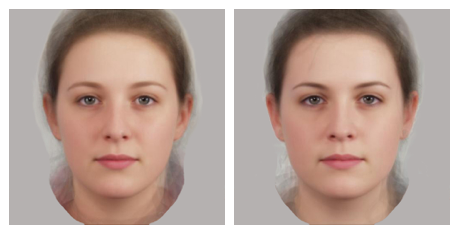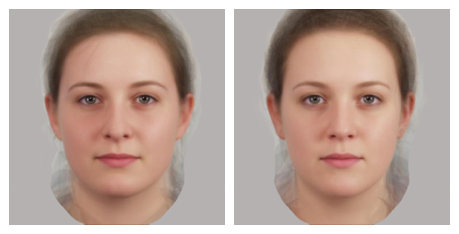Social inferences from faces
Humans are both highly visual and highly social beings. People are quick, perhaps to a fault, to make attributions of personality and other social traits on the basis of mere appearance. Why are we are so willing to make these judgements? It is very surprising to me, but social inferences from mere appearance can be accurate. Specifically, when people are asked to adopt a neutral pose for a photograph, the resulting image can be revealing of stable behavioural biases. Below are two examples taken from Kramer & Ward, 2010:
Agreeableness
Agreeableness is a trait derived from factor-analytic models of personality, relating to how warm, sympathetic, and interested someone is in other people.

The images above are computer averages of women photographed with a neutral, face forward posture. Which one looks more sympathetic? Most people say the face on the left, and that is correct. This perception is objectively correct because the face on the left is a composite image of 15 women in our sample who reported being the most sympathetic and agreeable on a standard personality inventory; the face on the right is an average of the 15 women who reported being the least agreeable. W
Results like this suggest that the faces of highly sympathetic and less sympathetic women contain different kinds of information, and observers can potentially extract this information to identify the different personalities.
There are some interesting things about these faces. The averaging process has produced face images that are similar. More than one person has spontaneously commented they look like sisters. The expressive differences are also pretty minimal. For example, neither has an obvious smile. This is even clearer if you use your hand to obscure the upper half of the face. However, the relatively small differences between the faces produce qualitatively different impressions.
Neuroticism
Another factor-analytic personality trait, relating to emotional stability, or the lack of it, anxiety, susceptibility to depression, etc. High trait neuroticism is a risk factor for many mental health conditions.

Which of these two faces looks more prone to mood swings? The face on the left is a composite image of 15 women who reported the highest levels of emotional stability; the image on the right, the 15 women who report the highest levels of neurotic traits, including mood swings and anxiety.
What is responsible for accurate judgements?
Not sure yet! In principle the correlation we see between appearance and behaviour could be the result of:
-
Appearance produces behaviour. A "self-fulfilling" prophecy, you might say. This is probably true in some cases. For example, we have seen that extraverts are rated as more attractive than introverts. It seems plausible that attractive people are more rewarded for being outgoing and sociable than less attractive people. The behavioural trait of extraversion could then reasonably be (at least in part) an effect of appearance. However, it seems unlikely all traits could be explained this way. For example, we tend to find that attractiveness is not a good predictor for traits: that is, attractive people are not necessarily agreeable or emotionally stable, even though these traits can be accurately identified.
-
Behaviour produces appearance. This one is harder to imagine, but certainly possible in principle. For example, someone who habitually frowns might have a tonic facial muscle posture of slightly knitted brows. In our composites, we do see, for example, that the low agreeable composite has a lower brow than the high agreeable one. One kind of behaviour we can probably rule out is posture: personality inferences could still be made accurately when posture was controlled through the use of 3D scans (Jones, Kramer, & Ward, 2012)
-
Third factors that cause both appearance and behaviour. There are many candidates here. The face and the brain are both the result of many many genes and environmental influences. The face is used as a diagnostic for many congenital and acquired behavioural conditions, such as Williams syndrome. Sex hormones, like testosterone, are known to influence both facial appearance (such as the jawline and brow) and behaviours (such as aggression). We are currently investigating how facial masculinity and femininity might be related to appearances associated with behaviour. For example, the low agreeable image above has a slightly more masculine jawline than the high.
Other examples
There is now quite a lot of evidence that trait inferences from neutral faces are not simply random, arbitrary, or "in the eye of the beholder". The list below is not comprehensive, just illustrative. You can refer to my publication page or elsewhere on this site for other examples from my lab.
Penton-Voak et al, 2006. Suggests a "kernel of truth" linking individual appearance and personality.
Little & Perrett, 2007. Uses composite faces like the above to show links between apperance and personality.
Boothroyd et al, 2008. Sociosexual orientation (interest in long-term vs short-term sexual relationships) and the face
Stirrat & Perrett, 2010. Trustworthy behaviours correlated with men's facial appearance.
Holtzman, 2011. Discrimination relating to the "dark triad" of psychoticism, narcissim and Machiavellianism.
Kramer, King, & Ward, 2011. Cross-species trait identification and the possibility of an evolved signal system.
Scott, Jones, Kramer, & Ward, 2013. Identifying depression and related misattributions.
And for a critical view on the accuracy of trait inferences from the face, see Todorov & Porter (2014). The view here is that variability of expression would overwhelm any valid facial cues. It is certainly true that someone smiling looks more agreeable than the same person frowning: that is, the "thin slice" of behaviour captured by the photograph is not representative of all behaviour. To my mind, we should therefore be careful to quality our results and say that when people are asked to adopt a neutral pose for a photograph, the resulting image can be revealing of stable behavioural biases.